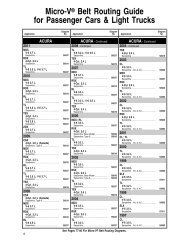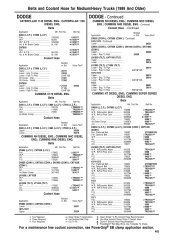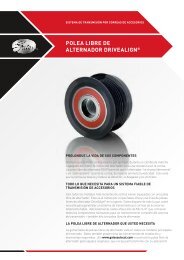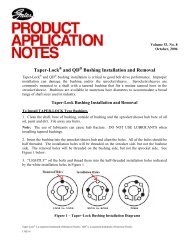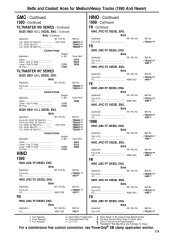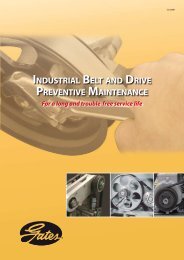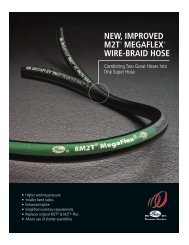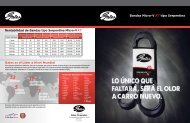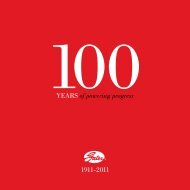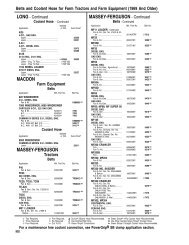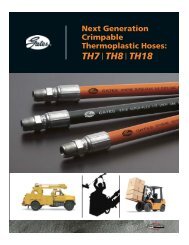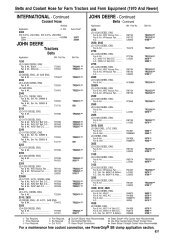Download Shaft And Hub Keyway And Key Sizes
Download Shaft And Hub Keyway And Key Sizes
Download Shaft And Hub Keyway And Key Sizes
Create successful ePaper yourself
Turn your PDF publications into a flip-book with our unique Google optimized e-Paper software.
Volume 56, No. 3April, 2009<strong>Shaft</strong> and <strong>Hub</strong> <strong><strong>Key</strong>way</strong> and <strong>Key</strong> <strong>Sizes</strong><strong>Key</strong>s connecting shafts to pulley hubs are commonly used to achieve reliable no-slip powertransmission in belt drive systems. This PA Note will explain the uses of keys and keyways inpulleys and bushings, and present current industry standards for key and keyway componentsizing.What is a <strong>Key</strong>, <strong>Key</strong>seat, and <strong><strong>Key</strong>way</strong>?<strong>Key</strong>: A demountable machinery part, which when assembled into keyseats, provides a positivemeans for transmitting torque between a shaft and a hub or bushing.<strong>Key</strong>seat: An axially located rectangular groove in a shaft, hub, or bushing. This may also bereferred to as shaft keyseat or hub keyseat or bushing keyseat when describing an exactapplication. The hub or bushing keyseat can be referred to as a keyway.<strong><strong>Key</strong>way</strong>: The hub or bushing keyseat.<strong>Key</strong>s and <strong><strong>Key</strong>way</strong>s: The BasicsIn order to lock a hub or bushing and shaft together, and prevent the shaft from rotating in thebore, a key is commonly inserted into a keyway that is machined in both the bore and shaft. Thekey is responsible for preventing rotation between the shaft and the bore, and carries a portion ofthe torque load. Improperly fitted keys and keyways -either too tight or too loose- can result inmechanical failures. Therefore, to ensure appropriate fit, the width and height dimensions ofstandard key and keyways must be held to recommended tolerances. Industry standards for keysizes in various bores exist for both English and Metric systems. A common standard availablefrom the Mechanical Power Transmission Association is MPTA-B1-2003. Another usefulindustry standard is ANSI Standard B17.1 for <strong>Key</strong>s and <strong>Key</strong>seats.Shallow <strong>Key</strong>sShallow keys are sometimes used when the shaft diameter approaches the maximum bushing orhub bore range. In order to accommodate the large shaft, the bore keyway depth is reduced. Thepower transmission capability of this arrangement is not reduced, but may not be as robust as astandard key and keyseat. Dimensional standards for “shallow key” sizes do not exist, somanufacturers generally furnish these special keys with their pulleys or bushings.17656-3
2Plain Bore Style PulleysIn larger plain bore style pulleys, a keyway must be machined into the bore with the correcttolerances. The fit between a finished pulley bore and its mating shaft must not allow relativemovement when the pulley is subjected to belt tension and torque loads. This is accomplishedwith the use of set screws, and by controlling the fit or clearance between the bore and themating shaft. Set screws do push shafts to one side of the bores causing eccentricity or radialrun-out, resulting in belt tension excursion and vibration. In order to minimize these potentiallynegative results, Gates publishes recommended shaft to bore fit tolerances for a range of shaftsizes. If cyclical or pulsating loads will be transmitted, an interference type fit is required.Interference fit tolerances for a range of shaft sizes are also published by Gates. Tablescontaining these recommended fit tolerances are available in any of the Gates Synchronous BeltDrive Design Manuals.In smaller minimum plain bore style pulleys, keys are not used. Set screws, along with the pressfit interaction between the bore and shaft, are relied upon to secure the hub to the shaft. Thistype of arrangement is generally sufficient for very light loads. In these cases, designers shouldevaluate the design loads to be sure the set screw holding torque is sufficient.Pulleys With BushingsIn order to achieve better concentricity as well as versatility in fitting numerous standard shaftsizes, tapered bushings are commonly used in pulleys. The most common bushing types used inindustrial power transmission applications are QD ® (Quick Disconnect – flanged type) and TL(Taper-Lock ® – flangeless type). Each system has its own merits and benefits.In most QD type bushings, a setscrew in the flange tightens against the key to prevent key loss inapplications subject to vibrating or pulsating loads, and in vertical shaft applications. Somebushing types are manufactured with an integral key that is formed as part of the bore. This alsoprevents potential key loss. Both types of bushings are popular in vertical shaft installations.<strong>Key</strong>less BushingsBesides keyed bushings, several types of keyless locking devices using a tapered wedge principleare available. These keyless bushings convert clamping action between inner and outer taperedrings into radial pressure that locks the device to the shaft and pulley. <strong>Key</strong>less bushings exertsignificantly greater radial hub loads compared to conventional tapered and keyed bushings.This requires that hubs be sufficiently sized to handle the increased hoop stress loads. <strong>Key</strong>lessbushings transmit high torque loads while maintaining excellent concentricity (minimal radialrun out and belt tension excursion). However, they are available in a limited number of boresizes and tend to cost more than conventional tapered and keyed bushings.Standard <strong>Key</strong> and <strong><strong>Key</strong>way</strong> SizingFigure 1 describes the dimensions used when specifying English and Metric keys and keyways.English Dimensions:<strong><strong>Key</strong>way</strong>: W x T 1<strong>Key</strong>: W x TMetric Dimensions:<strong><strong>Key</strong>way</strong>: W x h<strong>Key</strong>: W x TQD ® is a trademark of Emerson Electric.Taper-Lock ® is a trademark of Reliance Electric
3Figure 1 - <strong><strong>Key</strong>way</strong> and <strong>Key</strong> Size Dimension ReferenceSpecifying English <strong><strong>Key</strong>way</strong>sIn the English system, it is standard practice to dimension keyways. The hub keyway isdimensioned by its width and depth on the shaft – keyway sides. Referencing Figure 1, thekeyway dimension is W x T 1 .Unless otherwise specified, the shaft keyway is assumed to be standard. A list of standardkeyway and corresponding key sizes for English shafts are listed below in Table 1. The commonspecification dimension, <strong><strong>Key</strong>way</strong> Size, is highlighted.English Standard <strong><strong>Key</strong>way</strong> and <strong>Key</strong> <strong>Sizes</strong><strong>Shaft</strong> Diameter (in) <strong><strong>Key</strong>way</strong> (in)* <strong>Key</strong> (in)From To Width(W)Depth(T 1 )Width(W)Depth(T)5/16 7/16 3/32 3/64 3/32 3/321/2 9/16 1/8 1/16 1/8 1/85/8 7/8 3/16 3/32 3/16 3/1615/16 1 1/4 1/4 1/8 1/4 1/41 5/16 1 3/8 5/16 5/32 5/16 5/161 7/16 1 3/4 3/8 3/16 3/8 3/81 13/16 2 1/4 1/2 1/4 1/2 1/22 5/16 2 3/4 5/8 5/16 5/8 5/82 13/16 3 1/4 3/4 3/8 3/4 3/43 5/16 3 3/4 7/8 7/16 7/8 7/83 13/16 4 1/2 1 1/2 1 14 9/16 5 1/2 1 1/4 5/8 1 1/4 1 1/45 9/16 6 1/2 1 1/2 3/4 1 1/2 1 1/26 9/16 7 1/2 1 3/4 3/4 1 3/4 1 1/27 9/16 9 2 3/4 2 1 1/2* Common dimension specificationTable 1 - Standard English <strong><strong>Key</strong>way</strong> and <strong>Key</strong> Dimensions
4Specifying Metric <strong><strong>Key</strong>way</strong>sDimensioning and specifying Metric keys and keyways varies significantly from the Englishsystem. In the Metric system it is common practice to specify the key size. Referencing Figure1, the Metric key size is W x T. The keyway dimensions are also different from the Englishsystem. Metric keyways are dimensioned by width and depth as measured from the radius of theshaft to the center of the keyway. See dimensions W and h in Figure 1.Unless otherwise specified, the shaft keyway is assumed to be standard. Also, T 1 and T 2 are notnecessarily equal. The Metric system does not refer to keyseat or keyway dimensions as doesthe English system. Instead, key dimensions are specified. Note that metric keys are rectangularin shape, and not square as in the English system. A list of the standard key sizes andcorresponding keyways for Metric shafts are listed below in Table 2. The common specificationdimension, <strong>Key</strong> Size, is highlighted.Metric Standard Parallel <strong><strong>Key</strong>way</strong> and <strong>Key</strong> <strong>Sizes</strong><strong>Shaft</strong> Diameter (mm) <strong><strong>Key</strong>way</strong> (mm) <strong>Key</strong> (mm)*From To Width(W)Depth(h)Width(W)Depth(T)6 8 2 1.0 2 29 10 3 1.4 3 311 12 4 1.8 4 413 17 5 2.3 5 518 22 6 2.8 6 623 30 8 3.3 8 731 38 10 3.3 10 839 44 12 3.3 12 845 50 14 3.8 14 951 58 16 4.3 16 1059 65 18 4.4 18 1166 75 20 4.9 20 1276 86 22 5.4 22 1486 96 25 5.4 25 1496 110 28 6.4 28 16111 130 32 7.4 32 18131 150 36 8.4 36 20151 170 40 9.4 40 22171 200 45 10.4 45 25201 230 50 11.4 50 28231 260 56 12.4 56 32261 290 63 12.4 63 32291 330 70 14.4 70 36331 380 80 15.4 80 40381 440 90 17.4 90 45441 500 100 19.5 100 50* Common dimension specificationTable 2 - Standard Metric <strong><strong>Key</strong>way</strong> and <strong>Key</strong> Dimensions




